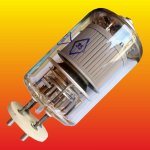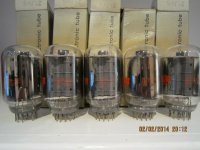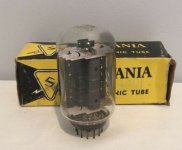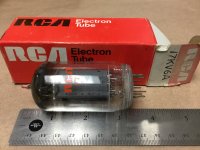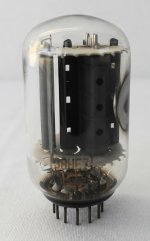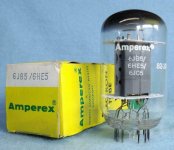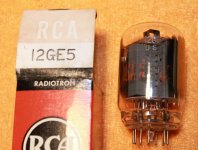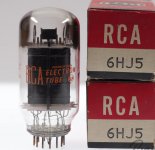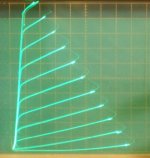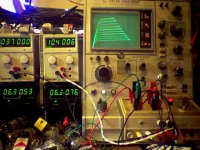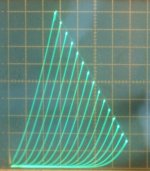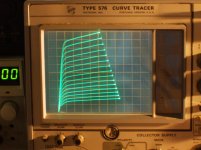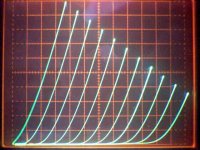The Radar pulse modulator type tubes likely will get one down to a practical output impedance for the OT if used at low B+. They generally have high heater power and so high emission capability. At least on par with TV Sweep tubes for continuous duty, if not even more.
The issue with some or most of the pulse modulator tubes is that they get their super high gm for handling the high pulsed currents by using a grid that is a square mesh, rather than the parallel grid wires used in most "linear" type tubes. And it is likely to be very closely spaced to the cathode too. They generally use positive grid drive too. This will give them more like a 5/2 power law characteristic. And bad discontinuous grid current loading on the previous driver stage. Lots of N Fdbk will be required to straighten them out for audio. They are likely to have a pentode like output impedance too, so not suitable for a SET design.
Beam triodes like 6JH5, 6JD5, 6HZ5 .... still require high voltage B+ to get any current out of them, so are mostly useless for audio except possibly for Electrostatic direct drive speakers. Driving the grid positive could help lower the required B+, but they are not rated for that, and would become non-linear drive loads besides.
The issue with some or most of the pulse modulator tubes is that they get their super high gm for handling the high pulsed currents by using a grid that is a square mesh, rather than the parallel grid wires used in most "linear" type tubes. And it is likely to be very closely spaced to the cathode too. They generally use positive grid drive too. This will give them more like a 5/2 power law characteristic. And bad discontinuous grid current loading on the previous driver stage. Lots of N Fdbk will be required to straighten them out for audio. They are likely to have a pentode like output impedance too, so not suitable for a SET design.
Beam triodes like 6JH5, 6JD5, 6HZ5 .... still require high voltage B+ to get any current out of them, so are mostly useless for audio except possibly for Electrostatic direct drive speakers. Driving the grid positive could help lower the required B+, but they are not rated for that, and would become non-linear drive loads besides.
Attachments
Last edited:
I'm not a fan of shoehorning these tubes into applications they weren't designed for. A lot of this stuff was designed for pulsed power with plate voltages in excess of 10kV, and their performance in linear operation at 500V is often mediocre at best.
Additionally, I feel like some of these tubes are rare and special enough that they're best left for applications that can utilize them best. Research labs regularly use this stuff, and there are plenty of basement RF/microwave enthusiasts who like to experiment with this equipment.
Additionally, I feel like some of these tubes are rare and special enough that they're best left for applications that can utilize them best. Research labs regularly use this stuff, and there are plenty of basement RF/microwave enthusiasts who like to experiment with this equipment.
I agree that the more exotic tubes are going to cost a bundle to get them to just produce mediocre results. Usually with dangerous B+ voltages too.
With expensive sockets, OTs, and power supplies.
Some of the best tubes cost just $1 to $3, with no exposed HV, and work with low Z primary OTs for good performance in audio. And can even be turned into
-real- "exotic" linear tubes using Crazy drive.
A few samples:
With expensive sockets, OTs, and power supplies.
Some of the best tubes cost just $1 to $3, with no exposed HV, and work with low Z primary OTs for good performance in audio. And can even be turned into
-real- "exotic" linear tubes using Crazy drive.
A few samples:
Attachments
I agree that the more exotic tubes are going to cost a bundle to get them to just produce mediocre results. Usually with dangerous B+ voltages too.
With expensive sockets, OTs, and power supplies.
Some of the best tubes cost just $1 to $3, with no exposed HV, and work with low Z primary OTs for good performance in audio. And can even be turned into
-real- "exotic" linear tubes using Crazy drive.
A few samples:
That a Tek 576 curve tracer?
Part of the problem is that this obnoxious single-end-triode buzz means that people see a big triode and thing "Great audio amp!", when in fact many of them are about the worst possible choice for audio. There are exceptions, like the 845 (which is a crap RF tube anyways), but the 2C39, for example, is considered "not worth it" for anything below VHF. Nobody builds an HF amplifier using 2C39s. Also, I could be wrong, but I want to say that a 2C39 audio amp would be nearly impossible to stabilize.
Honestly, tubes like the 6L6GC and the KT88 are popular for a reason- they're great tubes for audio work.
That a Tek 576 curve tracer?
Yup, modified for tube curve tracing. 170V step range, screen grid V auto selection, variable (continuous) step size, up to 15 curves, screen current curves, screen drive curves, Crazy drive curves, screen current limiting or minimum plate V option (for knees)... 700 V plate scale besides the 350 V plate scale (I got rid of the 1500 V plate scale, too dangerous).
Attachments
Last edited:
Better idea:
Go get your Technician (and while you're at it, the General is easy enough) license.....
Remember that the OP is in Iran. I'm sure that the rules for ham radio are a bit different there. Tubes and parts that we take for granted may not be so common in other parts of the world either.
That said, I will play with just about any tube, and this included the 2C39, since I had a box full of them. I tried to make them work for audio, and decided that the results I got were not worth the effort and high voltages / impedances needed to make them work. I gave them to a friend who made a 1 KW RF amp for EME use at 1296 MHz with 6 or 8 of them. Since he happened to be a sales engineer for Motorola / Freescale he kept working on a solid state amp with similar specs, but went back to the tube amp every time the SS amp blew up.
Remember that the OP is in Iran. I'm sure that the rules for ham radio are a bit different there. Tubes and parts that we take for granted may not be so common in other parts of the world either.
That said, I will play with just about any tube, and this included the 2C39, since I had a box full of them. I tried to make them work for audio, and decided that the results I got were not worth the effort and high voltages / impedances needed to make them work. I gave them to a friend who made a 1 KW RF amp for EME use at 1296 MHz with 6 or 8 of them. Since he happened to be a sales engineer for Motorola / Freescale he kept working on a solid state amp with similar specs, but went back to the tube amp every time the SS amp blew up.
Yeah, it's a bit hard to find these tubes and I don't think anyone uses a ham radio in here. But typical electronics parts aren't a problem.
I was REALLY lucky to find this. I don't even know how the sales person got this TBH.
He had 2 of these, one Eimac and one Siemens.
He also had a TM-85. I didn't purchase that one because it was both more expensive than these and I couldn't find a datasheet for it. I think it's still up for sale.
Any old TVs (tube) to be found?
Yes, there are normal TV vacuum tubes, but they are mostly low power. There are tons of PCL504s, PCL805s, PL500s etc. for less that $4.
I actually have 2 PCL805s
My apologies. My flag recognitions skills are what you'd expect from an engineering major (maybe worse, TBH). I thought that was the Indian flag- oops. As a side note, it's pretty cool just how international this forum is.
Ah no worries man.
Yeah, it's pretty cool.
You mentioned the PL500 / PL504 TV tube. There is a thread on this forum about a PL504 low voltage amplifier that may be built with cheap parts by beginners on tube amplifiers. Low Voltage (60V) Stereo Tube Amplifier for Dummies (2+2W)
This tube (PL500 - PL504 - 28GB5) at regular voltage has been used since the '60 on cheap but powerful push-pull guitar amplifiers. EL504 is the 6V heater version.
This tube (PL500 - PL504 - 28GB5) at regular voltage has been used since the '60 on cheap but powerful push-pull guitar amplifiers. EL504 is the 6V heater version.
Thanks for the link and stuff!You mentioned the PL500 / PL504 TV tube. There is a thread on this forum about a PL504 low voltage amplifier that may be built with cheap parts by beginners on tube amplifiers. Low Voltage (60V) Stereo Tube Amplifier for Dummies (2+2W)
This tube (PL500 - PL504 - 28GB5) at regular voltage has been used since the '60 on cheap but powerful push-pull guitar amplifiers. EL504 is the 6V heater version.
I will not be able to make one for at 3 months as I will be spending my money on a multimeter and some other stuff
It will have to wait.
But thanks again!
one of the 4CX family tubes should work strapped as quasi triode, worth a try if you can find a socket for it
At least in tetrode mode, the more modest size 4CX-es, like the 4cx250 and the 4cx150 have a reputation of being very unlinear, to the point that they've become very un-preferred even for RF linear amplification. I don't know whether that would improve triode-connected. They also demand a lot of airflow (noisy blower). The larger 4cx-series (if they happen to be more linear, not sure) are ferociously expensive, if/ when you can even find them.
Beyond that mess, take a moment to think about what it would be like to design a chassis for a 4CX series amplifier. It wouldn't be easy, and it certainly wouldn't have the "sexy" appearance of an amp that uses glass tubes.
I see very few RF projects using the 4CX250, which is telling given the fact that you can pick them up for very little on eBay.
I see very few RF projects using the 4CX250, which is telling given the fact that you can pick them up for very little on eBay.
Connections aren't a problem for this 2C39A.Beyond that mess, take a moment to think about what it would be like to design a chassis for a 4CX series amplifier. It wouldn't be easy, and it certainly wouldn't have the "sexy" appearance of an amp that uses glass tubes.
I see very few RF projects using the 4CX250, which is telling given the fact that you can pick them up for very little on eBay.
I used 2 metal springy rings for the anode and grid with wires soldered on the rings and for the cathode and the heater, I'm using a female BNC connector with a piece of copper inside the center hole to make connection with the heater contact. The ground of the BNC connected to the cathode, is friction-fit.
At least in tetrode mode, the more modest size 4CX-es, like the 4cx250 and the 4cx150 have a reputation of being very unlinear, to the point that they've become very un-preferred even for RF linear amplification. I don't know whether that would improve triode-connected. They also demand a lot of airflow (noisy blower). The larger 4cx-series (if they happen to be more linear, not sure) are ferociously expensive, if/ when you can even find them.
Linearity in quasi triode is also unknown to me, but may be worth to investigate.
Cooling should not be to much of a prob, you do not need a high pressure fan.
Philips had a version that did not require a high pressure fan.
The tube was mounted with a beryllium oxide washer to a heatsink.
Instead of cooling fins the tube had a mounting block soldered to the anode.
Something like that could easily be made and fitted.
You do not have to remove the fins considering the by Ug2 and Ik limited lowish anode dissipation.
The fins can handle 100W heatflow to the heatsink without problems.
Last edited:
Linearity in quasi triode is also unknown to me, but may be worth to investigate.
Cooling should not be to much of a prob, you do not need a high pressure fan.
Philips had a version that did not require a high pressure fan.
The tube was mounted with a beryllium oxide washer to a heatsink.
Instead of cooling fins the tube had a mounting block soldered to the anode.
Something like that could easily be made and fitted.
You do not have to remove the fins considering the by Ug2 and Ik limited lowish anode dissipation.
The fins can handle 100W heatflow to the heatsink without problems.
The 8873 triode was also run conduction cooled to a heatsink, but is unobtanium.
Only centrifugal blowers are effective at working against the sort of back pressure involved in pushing air through the fins of a ceramic metal tube, and centrifugal blowers, with rare exception, are anything but silent.
In the aircooled CX's I doubt that there would be very much sideways heat conduction through the fins, which were designed to have a lot of surface area and not a lot of cross-section.
If someone really wants to torture some 4cx150s or 250s without airflow, the sockets, mentioned somewhere else above as thought to be hard to source, are actually just versions of the "loctal" socket as used with the oddball "7" series glass envelope small signal tubes that never really caught on.
I'll stop sidetracking the original post-er's thread about the 2c39- other than to note that if someone really wanted to color way outside the lines, one could seal around the base of the 2c39 anode with a heat resistant viton o-ring, then build a water jacket around the anode, fill with distilled water, and then operate "vapor phase" cooling. Sound ridiculous?- google "Alpha 70V" for an RF amp in the 1.5kw range that used a system like that. Physics of dissipating the heat are much like the old "open hopper" single cylinder engines, a tremendous amount of heat is absorbed in changing water from liquid to vapor state. Might also be able to adapt a vapor-phase cooling system for one of the Soviet surplus external anode/detachable heatsink triodes like the gi7b
...gotta go top off the water levels in my amp now...
Last edited:
- Status
- This old topic is closed. If you want to reopen this topic, contact a moderator using the "Report Post" button.
- Home
- Amplifiers
- Tubes / Valves
- 2C39A as the Output Tube
